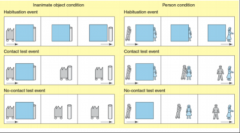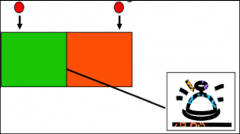![]()
![]()
![]()
Use LEFT and RIGHT arrow keys to navigate between flashcards;
Use UP and DOWN arrow keys to flip the card;
H to show hint;
A reads text to speech;
19 Cards in this Set
- Front
- Back
|
Define causal reasoning |
the understanding of the cause and effect of physical and mental events. |
|
|
In pre-verbal infants, what can we test to measure the extent of their causal reasoning? (3) |
1. perception of causality 2. attributions of agency 3. causality of behaviour |
|
|
Describe Leslie and Keeble's (1987) experiment testing infants' perception of causality. |
6 month old infants Red block moves towards green block which moves off when touched by the red block A) Immediately B) After a 0.5s delay
The video is then shown in reverse so that the green block launches the red, immediately or after a short delay.
Results: infants dishabituate to the green immediate launching of the red after red immediate launching of the green. This could be due to the infant's recognition of a change in causal agent and therefore an awareness of causality. |
|
|
Describe Gergely et al.'s (1995) experiment investigating attributions of agency and understanding of rationality in infants. |

When the block is removed, 12 month olds dishabituate more to the old jumping action than to the new, rational action. |
|
|
Describe Spelke et al.'s (1995) experiment looking at infants' perceptions of causality with interactions between animate and inanimate objects. |

7 month old infants only dishabituated to the inanimate object no-contact test trials
|
|
|
Do children understand object transformations? Give an example of an experiment investigating this. |
Gelman et al. (1980) 3 and 4 year olds 3 picture sequences read from left to right Children are given the first two pictures (an object and a transformation event) and are asked to pick the right picture to complete the sequence from three options.
Both 3 and 4 year olds are relatively accurate, though 4 year olds are better than 3 year olds. |
|
|
What are the four Humean causal principles? |
1. the priority principle 2. the covariation principle 3. the temporal contiguity principle 4. the similarity principle |
|
|
Describe an experiment testing children's understanding of the priority principle. |

Bullock and Gelman (1979) 3-5 year olds Marble/jack-in-the-box experiment
Performance improves with age but even at 3 children's success rate is much higher than chance. |
|
|
Describe an experiment testing children's understanding of the covariation principle. |

Shultz and Mendelson (1975) 3 and 4 year old children Lever-light covariation patterns
Both 3 and 4 year olds correctly identify the causal agent (lever 1) |
|
|
Describe an experiment testing children's understanding of the contiguity principle. |

Mendelson and Shultz (1975) 4-7 year olds Green/orange box with marbles, a bell, and a delay. Additional manipulation of bell position in relation to box.
4-7 year olds all answered correctly in both conditions. |
|
|
Describe an experiment testing children's understanding of the similarity principle. |
Schultz and Ravinsky (1977 6, 8, 10 and 12 year old children Container of pink water + one opaque bottle with pink lid and one opaque bottle with blue lid. "Which bottle made the water pink?" All children (+3 year olds) answer - pink lidded bottle
|
|
|
In the following situations of conflicting information, at what age do children stop using the similarity principle?
|
similarity/temporal contiguity: 8+ years similarity/covariation: 10+ years |
|
|
What are causal Bayes nets? |
a statistical model that predicts the effects of interventions in simple and complex causal structures. |
|
|
Describe the 'blicket detector' experimental paradigm |
"This is a blicket detector, it plays music when it detects a blicket." One cause condition: B is placed on the detector, nothing happens. B is removed. A is placed on the detector, detector sings. B is added, detector continues to sing. "which object is the blicket? which would you remove to stop the music?" Results: children are successful
Two cause condition: B is placed on detector, it sings. B is removed, it stops. A is placed on detector, it sings. B is placed on detector, it continues. - repeated 3x so that B activates it 3x and A activates is 2x. "same questions" Results: children take off both A and B - they recognise that although there were inconsistencies, A is still statistically likely to be a blicket. |
|

In Kaiser et al.'s 1986 study of adult understanding of projectile motion, which of these options was the correct projectile. Which do most adults think is the correct option? |
Correct: 3 Most frequently chosen: 5 and 6
Requires an understanding of Newtonian physics because the correct answer is not necessarily intuitive for everyone. Perceptual experience is insufficient. |
|
|
What is the 'tubes task'? How does it demonstrate that children's understanding of gravity requires more than the perceptual experience that they are likely to have had at a young age? At what age do children pass the tubes task? |

Hood et al. (1995) 2- 4 year olds Children struggle with the task when asked to 'find' the ball they've just dropped into one of the tubes. Difficulty increases as more tubes are added. By 3.5 years they are pretty consistently accurate.
|
|
|
What is metacognition? Metacognition gives you active control and reflection over your own... what? (3) |
thinking about one's own thinking/cognition
1. information processing skills 2. cognitive strategies 3. organisation and monitoring of progress |
|
|
What is metarepresentation? |
thinking about the cognition of others |
|
|
What differences did Kuhn (2000) find in the metacognitive abilities of 3 and 4 year olds? |
3 year olds: hold some awareness of themselves and others as 'knowers' and of the difference between thinking about things and perceiving them.
4 year olds: understand that others' behaviours are guided by beliefs that may be different from their own. |

